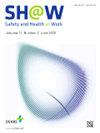Measuring Potential of a Candidate for a Job in the Light of Psychotechnical Tests and the Use of Selected Methods of Multivariate Analysis
IF 2.9
3区 医学
Q1 PUBLIC, ENVIRONMENTAL & OCCUPATIONAL HEALTH
引用次数: 0
Abstract
Background
The article presents a way to use the so-called "raw” results of psychotechnical tests in the process of broadly understood personnel policy. Based on the "raw” results of psychotechnical tests, the authors performed the so-called synthetic/aggregate assessments. From a computational perspective, the study employed: a popular multiattribute decision making (MADM) method—the Development Meter method—for decision-making evaluation. Czekanowski's method, one of the earliest and most significant approaches to object clustering.
Methods
The proposed computational procedures using the synthetic meter and Czekanowski's method are discussed based on the results of tests conducted on a group of students on selected apparatuses that allow the implementation of psychotechnical tests, in relation to which reaction time plays a key role (the Piórkowski apparatus, a cross apparatus, a reaction time meter and Poppelreuter tables).
Results
The authors used the results of a psychotechnical study conducted on a randomly selected group of full-time students through the use of two selected taxonomic methods to linearly organize the classified "objects,” determine their similarity/differences, and group them. In the Development Meter method, objects were compared to abstract reference solutions (ideal objects), allowing the calculation of distances between each object and the reference solution(s). In Czekanowski's method, perceived as a universal statistical classification technique, a Euclidean distance matrix was used to define similarity intervals by categorizing distances into different classes.
Conclusion
In the future, the authors would like to use the above-mentioned method for cyclic analysis of the results of measurements obtained on the entire population of students,which can provide important information for entrepreneurs looking for graduates with specific psychophysical predispositions.
根据心理技术测试和使用多元分析的选定方法来测量候选人的工作潜力
本文提出了一种在广泛理解的人事政策过程中使用所谓心理技术测试“原始”结果的方法。根据心理技术测试的“原始”结果,提交人进行了所谓的综合/综合评估。从计算的角度来看,本研究采用了一种流行的多属性决策(MADM)方法——发展量表法(Development Meter method)进行决策评估。Czekanowski的方法,最早也是最重要的对象聚类方法之一。方法根据对一组学生在选定的允许实施心理技术测试的设备上进行的测试结果,讨论了使用合成仪表和切卡诺夫斯基方法的拟议计算程序,其中反应时间起着关键作用(Piórkowski装置,交叉装置,反应时间计和Poppelreuter表)。结果作者利用随机选取的全日制学生进行的心理技术研究结果,通过两种选择的分类方法,将分类的“对象”线性组织,确定其相似性/差异性,并将其分组。在开发测量方法中,将对象与抽象参考解决方案(理想对象)进行比较,从而计算每个对象与参考解决方案之间的距离。切卡诺夫斯基的方法被认为是一种通用的统计分类技术,该方法使用欧几里得距离矩阵通过将距离划分为不同的类别来定义相似区间。结论在未来,作者希望利用上述方法对整个学生群体的测量结果进行循环分析,为企业家寻找具有特定心理生理倾向的毕业生提供重要信息。
本文章由计算机程序翻译,如有差异,请以英文原文为准。
求助全文
约1分钟内获得全文
求助全文
来源期刊

Safety and Health at Work
Social Sciences-Safety Research
CiteScore
6.40
自引率
5.70%
发文量
1080
审稿时长
38 days
期刊介绍:
Safety and Health at Work (SH@W) is an international, peer-reviewed, interdisciplinary journal published quarterly in English beginning in 2010. The journal is aimed at providing grounds for the exchange of ideas and data developed through research experience in the broad field of occupational health and safety. Articles may deal with scientific research to improve workers'' health and safety by eliminating occupational accidents and diseases, pursuing a better working life, and creating a safe and comfortable working environment. The journal focuses primarily on original articles across the whole scope of occupational health and safety, but also welcomes up-to-date review papers and short communications and commentaries on urgent issues and case studies on unique epidemiological survey, methods of accident investigation, and analysis. High priority will be given to articles on occupational epidemiology, medicine, hygiene, toxicology, nursing and health services, work safety, ergonomics, work organization, engineering of safety (mechanical, electrical, chemical, and construction), safety management and policy, and studies related to economic evaluation and its social policy and organizational aspects. Its abbreviated title is Saf Health Work.
 求助内容:
求助内容: 应助结果提醒方式:
应助结果提醒方式:


